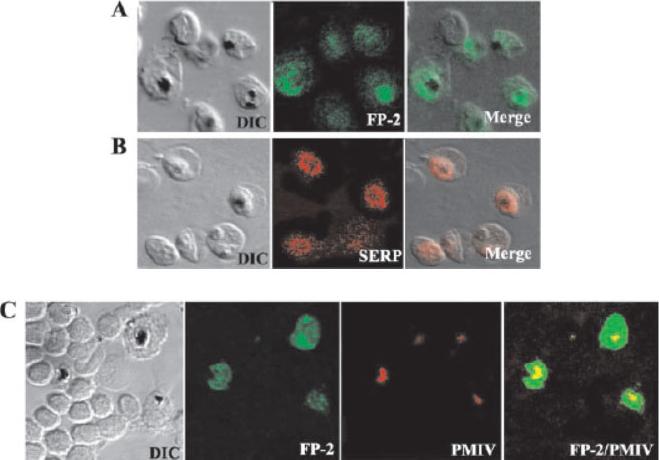PF3D7_0219400 ribosome associated membrane protein RAMP4, putative, unspecified product
Disruptability [+]
| Species | Disruptability | Reference | Submitter | |
|---|---|---|---|---|
| P. falciparum 3D7 |
Refractory |
USF piggyBac screen (Insert. mut.) | USF PiggyBac Screen | |
| P. berghei ANKA |
Possible |
PlasmoGEM (Barseq) | PlasmoGEM | |
Mutant phenotypes [+]
| Species | Stage | Phenotype | Reference | Submitter |
|---|---|---|---|---|
| P. berghei ANKA | Asexual |
No difference |
PlasmoGEM (Barseq) | PlasmoGEM |
Imaging data (from Malaria Metabolic Pathways)

Immunolocalization of FP-2 by confocal microscopy. Erythrocytes infected with P. falciparum trophozoites were smeared on a glass slide, fixed with ice-cold methanol, and incubated with polyclonal FP-2 (A) or SERP (B) antibodies followed by Alexa 488 (green) or Alexa 594 (red) conjugated goat anti-rabbit IgG. Merged images of differential interference contrast (DIC) and fluorescence microscopy are shown on the right. C and D, slides were incubated with polyclonal FP-2 together with either plasmepsin IV (C) antibodies followed by Alexa-488-conjugated (green) goat anti-rabbit IgG and Alexa 594-conjugated (red) goat anti-mouse IgG. Merged images of green and red micrographs are shown on the right. The FP-2 antibody stained the entire trophozoite and vesicles or vesicle-like structures of unknown identity were seen extending into the erythrocyte cytoplasm. Co-staining of infected erythrocytes with antibodies to plasmepsin IV, which is present exclusively in the food, confirmed that FP-2 is present in the food vacuole as well as in the area that lies outside of the food vacuole (C). A comparison of FP-2 and SERP staining shows that the FP-2 is localized in the PVM as well as in a compartment that is distinct from the PVM.Dhawan S, Dua M, Chishti AH, Hanspal M. Ankyrin peptide blocks falcipain-2-mediated malaria parasite release from red blood cells. J Biol Chem. 2003 278:30180-6
See original on MMP
Biotin localizes to the parasitophorous vacuole. Trophozoite-infected erythrocytes were permeabilized with SLO, biotin-labeled, and spread onto microscope slides. Cells were fixed and incubated with antibodies to SERP (A), a vacuolar resident protein. Conjugated secondary antibodies (green color) co-localize with Cy3-conjugated streptavidin (red color). B and C show dual labeling of biotin and the erythrocyte membrane protein band 3 (B) or of biotin and the parasite cytosolic protein aldolase (C). Cells were imaged using a laser scanning confocal microscope. The left panels (TM/nomarski) show the transmission images of the respective fields, and the right panels (merge) show an overlay of fluorescence images for each of the antibodies used. The images show a distinct ring around the periphery of the intracellular parasite. The biotin co-localizes with the vacuolar marker protein SERP (A). This location is distinct from the location of the erythrocyte membrane protein band 3 and from the location of the parasite cytosolic protein aldolase (B and C). A ring-like staining around the periphery of the parasite can be attributable to a reaction of the biotin with membrane proteins of the PVM and with soluble vacuolar proteins.Nyalwidhe J, Baumeister S, Hibbs AR, Tawill S, Papakrivos J, Volker U, Lingelbach K. A nonpermeant biotin derivative gains access to the parasitophorous vacuole in Plasmodium falciparum-infected erythrocytes permeabilized with streptolysin O. J Biol Chem. 2002 277:40005-11.
See original on MMPMore information
| PlasmoDB | PF3D7_0219400 |
| GeneDB | PF3D7_0219400 |
| Malaria Metabolic Pathways | Localisation images Pathways mapped to |
| Previous ID(s) | PF02_0181, PF3D7_0219400.1, PF3D7_0219400.2, PFB0888w |
| Orthologs | PBANKA_0315800 , PCHAS_0317900 , PKNH_0401500 , PVP01_0405600 , PVX_002585 , PY17X_0316500 |
| Google Scholar | Search for all mentions of this gene |